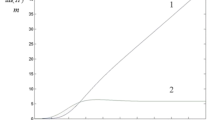Abstract
A series of experiments were performed in a rotating annulus of fluid to study effects of rotation rate on planetary-scale baroclinic wave flows. The experiments reveal that change in rotation rate of fluid container causes variation in Rossby number and Taylor number in flows and leads to change in flow patterns and in phase and amplitude of quasi-stationary waves. For instance, with increasing rotation rate, amplitude of quasi-stationary waves increases and phase shifts upstream. On the contrary, with decreasing rotation rate, amplitude of quasi-stationary waves decreases and phase shifts downstream. In the case of the earth’s atmosphere, although magnitude of variation in earth’s rotation rate is very small, yet it causes a very big change in zonal velocity component of wind in the atmosphere and of currents in the ocean, and therefore causes a remarkable change in Rossby number and Taylor number determining regimes in planetary-scale geophysical flows. The observation reveals that intensity and geographic location of subtropic anticyclones in both of the Northern and Southern Hemispheres change consistently with the variation in earth’s rotation rate. The results of fluid experiments are consistent, qualitatively, with observed phenomena in the atmospheric circulation.
Similar content being viewed by others
References
Allen, C. W. (1973), Astrophysical quantities, 3rd. ed., London Athlone.
Chen, R. R. and Li Guoqing (1982), An experimental simulation on the mechanical effect of Tibetan Plateau on zonal circulation of stratified atmosphere,Sci. Sin. Ser. B,25: 1091–1102.
Dickey, J. O., T. M. Eubanks and J. A. Steppe (1985), High accuracy earth rotation and atmospheric angular momentum, In: Nato advanced research workshop on earth rotation: solved and unsolved problems.
Greenspan, H. P. (1969),The theory of rotating fluids, Cambridge Univ. Press, London.
Hide, R. (1983), On the dynamics of rotating fluids and planetary atmospheres: a summary of some recent work,Pure and Applied Geophysics, Basel,121(3): 365–374.
Lambeck, K. and A. Cazenave (1976), Long term variations in the length of day and climatic change,Geophys. J. Roy. Astron. Soc. 46: 555–573.
——— (1980),The earth’s variable rotation: Geophysical causes and consequences, Cambridge, Cambridge Univ. Press.
Li, G. Q., R. Kung and R. L. Pfeffer (1986), An experimental study of baroclinic flows with and without two-wave bottom topography,J. Atmos. Sci.,43: 2585–2599.
Li Guoqing, R. Kung and R. L. Pfeffer (1992), A fluid experiment of large-scale topography effect on baroclinic wave flows,Advances in Atmos. Sci.,9: 17–28.
Peng Gongbing, Lu Wei and Yin Yanzhen (1982), Response of climate and its atmospheric circulation factors on change in the earth’s rotation rate,Acta Meteor. Sin.,40: 209–218.
Pfeffer, R. L., R. Kung and G. Q. Li (1989), Topographically-forced waves in a thermally driven rotating annulus of fluid-experiment and linear theory,J. Atmos. Sci.,46: 2331–2343.
Pfeffer, R. L., J. Ahlquist, R. Kung, G. Q. Li and Y. Chang (1990), A study of baroclinic wave behavior over bottom topography using complex principal component analysis of experimental data,J. Atmos. Sci.,47: 67–81.
Ren Zhenqiu and Zhang Suqin (1986), Deceleration of earth’s rotation and formation of El Nino,Acta Meteor. Sin.,44: 411–416.
Rosen, R. D. and D. A. Salstein (1983), Variations in atmospheric angular momentum on global and regional scales and length of day,J. Geophys. Res.,88: C9, 5451–5470.
Teramoto, T. (1974), Large-scale variation of air-sea system in the North Pacific Ocean,Science (Japan),44: 685–693.
Zhao Wenje (1990), Numerical experiment on the effect of deceleration of earth rotation on the atmosphere., Graduation thesis, Institute of Atmospheric Physics, Chinese Academy of Sciences.
Zheng Dawei, Luo Shifang and Song Guoxuan (1989), Interannual variation of earth rotation, El Nino events and angular momentum,Science in China, Ser. B. 32(6): 729–736.
Author information
Authors and Affiliations
Rights and permissions
About this article
Cite this article
Guoqing, L., Kung, R. & Pfeffer, R.L. Some effects of rotation rate on planetary-scale wave flows. Adv. Atmos. Sci. 10, 296–306 (1993). https://doi.org/10.1007/BF02658135
Received:
Revised:
Issue Date:
DOI: https://doi.org/10.1007/BF02658135




